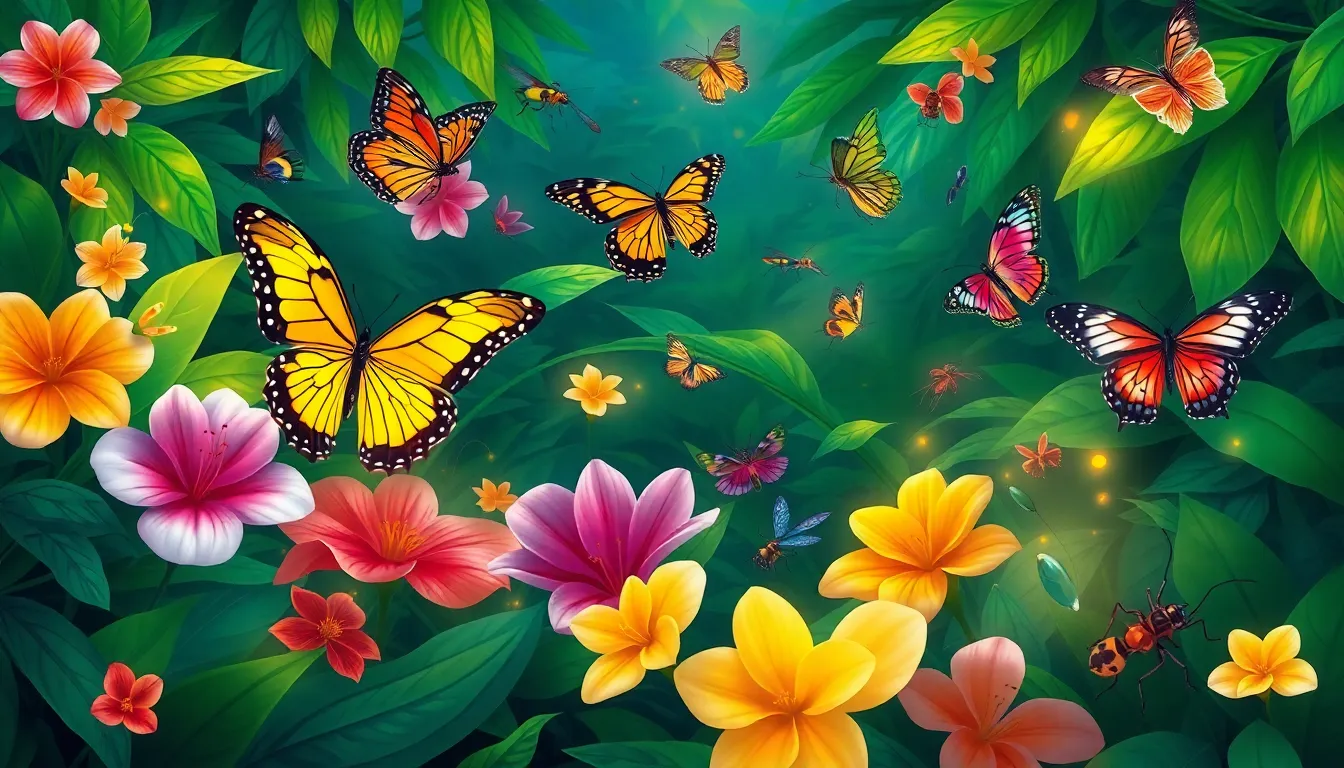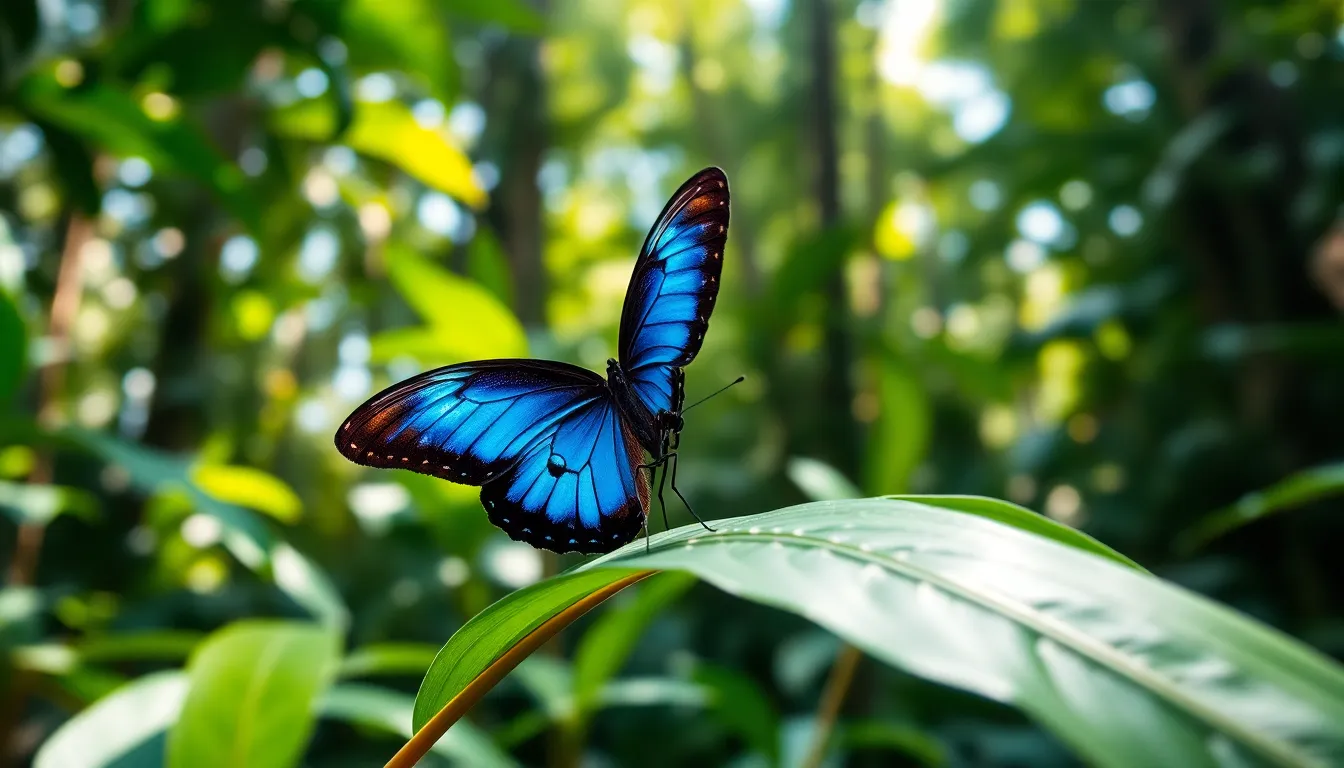Deep in the heart of the rainforest, a bustling community of insects thrives, proving that size doesn’t matter when it comes to making an impact. From the dazzling morpho butterfly to the industrious leafcutter ant, these tiny creatures play vital roles in their ecosystems, and they’ve got some serious skills. They might not have the charisma of a jaguar or the grace of a sloth, but trust us, their contributions are nothing short of extraordinary.
Rainforest Insects
Rainforest insects represent a diverse and essential group of species within this unique ecosystem. These insects contribute to pollination, nutrient cycling, and serve as a food source for various animals. The morpho butterfly showcases vibrant colors, attracting attention with its striking appearance while playing a crucial role in pollinating plants. Leafcutter ants exhibit remarkable abilities; they cultivate fungus as their primary food source, influencing the forest’s vegetation dynamics.
Other notable species include fireflies, known for their bioluminescence, which aids in mating communications, and the army ant, famous for its aggressive foraging tactics. Diverse adaptations help rainforest insects thrive in their environment, with some developing camouflage to avoid predation while others possess toxic traits to deter threats. This variability creates complex interactions within the ecosystem, demonstrating the intricate balance of life.
In terms of population, it is estimated that rainforest insects outnumber all other rainforest species combined, signifying their ecological importance. The interplay between these insects and other organisms, like birds and mammals, supports food webs. Additionally, their activities contribute to soil formation, enhancing the forest’s health and resilience. Various insect species establish symbiotic relationships with plants, aiding in seed dispersal and ensuring the reproduction of numerous flora.
Rainforest insects are often overlooked due to their size, yet their impact is profound. Their collective presence underscores the intricacy of rainforest ecosystems, reflecting a web of interconnected roles that sustain life within these biodiverse habitats.
Importance of Rainforest Insects

Rainforest insects play a vital role within their ecosystems. Pollination, nutrient cycling, and food production highlight their significance in maintaining ecological balance.
Role in Ecosystems
Insects like morpho butterflies contribute significantly to pollination, ensuring the growth of diverse plant life. Leafcutter ants cultivate fungus, recycling plant material and enhancing soil fertility. Unsung heroes such as army ants maintain population control of other insect species, thereby preserving ecosystem integrity. Fireflies engage in bioluminescence to attract mates, contributing to population sustainability. The complex interactions between these insects and various flora and fauna underpin the stability of rainforest ecosystems, facilitating a network of life that thrives despite challenges.
Contributions to Biodiversity
Biodiversity thrives in rainforests, in large part due to insects. Various species serve as pollinators, helping to maintain diverse plant communities crucial for animal habitats. Insects attract other wildlife, fostering rich food webs within the forest environment. Unique relationships, such as those between ants and plants, enhance seed dispersal and support flora reproduction. Without these insects, biodiversity would decline sharply, diminishing the rainforest’s capacity to support countless organisms. Their presence exemplifies the intricate connections that sustain life, reaffirming the critical role insects play in the overall health of rainforest ecosystems.
Types of Rainforest Insects
Rainforest insects encompass a wide variety of species, each with unique characteristics and ecological roles. Their diversity contributes significantly to the health of these ecosystems.
Beetles
Beetles represent the largest group of rainforest insects, with thousands of species thriving in these environments. Their armor-like exoskeletons provide excellent protection. Many beetles, like the rhinoceros beetle, display impressive sizes and fascinating adaptations. These insects play vital roles in decomposition, helping break down organic matter and recycling nutrients into the soil. Certain types, such as ladybugs, love feeding on pests, directly benefiting plant health. Overall, the presence of beetles stimulates the ecological balance within rainforest habitats.
Butterflies
Butterflies add vibrant colors and intrigue to rainforest ecosystems. The morpho butterfly is one of the most notable species, known for its striking iridescent wings. These insects participate in pollination, transferring pollen from flower to flower as they feed. Their life cycles, which include a metamorphosis from caterpillar to adult, illustrate the complexity of rainforest life. Additionally, butterflies serve as food for various predators, creating a vital link in food webs. The abundance of butterflies enhances biodiversity, showcasing their essential ecological role.
Ants
Ants demonstrate remarkable social structures and behaviors within rainforest settings. Leafcutter ants are particularly interesting, as they cut leaves to cultivate fungus—an essential food source for their colonies. These insects contribute to nutrient cycling by breaking down plant material. Army ants exhibit aggressive foraging tactics, influencing insect populations in their habitats. Many ant species also form symbiotic relationships with other organisms, including plants and aphids. Together, ants enhance soil fertility and promote the overall health of rainforest ecosystems. Their interactions create dynamic communities that support the rainforest’s rich biodiversity.
Adaptations of Rainforest Insects
Rainforest insects exhibit remarkable adaptations that enhance their survival in the complex ecosystem. Two key strategies include camouflage, mimicry, and communication.
Camouflage and Mimicry
Camouflage serves as a vital survival mechanism among rainforest insects. Many species blend seamlessly with their surroundings, using patterns and colors that mimic foliage, bark, or even other insects. This adaptive strategy helps prevent predation. For example, stick insects resemble twigs, making them nearly invisible to predators. Mimicry is equally impressive; some insects imitate the colors or patterns of toxic species to deter potential threats. Butterflies often exhibit this behavior, as they mimic the coloration of poisonous species to gain protection from predators. Such traits contribute to a delicate balance in the rainforest, where visibility can determine survival.
Communication Strategies
Communication among rainforest insects relies on diverse methods to convey information. Many species utilize pheromones, chemical signals that facilitate interaction within their colonies. Leafcutter ants, for instance, release specific pheromones to signal foraging routes or warn of danger. Acoustic signals also play a role; crickets produce rhythmic sounds to attract mates or ward off rivals. Visual communication occurs as well, particularly in species like fireflies, which employ bioluminescence to attract partners through light displays. These communication strategies enhance social cohesion and reproductive success, crucial for species persistence in the dense rainforest habitat.
Threats to Rainforest Insects
Rainforest insects face significant threats that disrupt their ecosystems. Understanding these challenges helps highlight the fragility of their habitats.
Habitat Loss
Habitat loss ranks among the most pressing threats to rainforest insects. Deforestation, primarily driven by agriculture and urban expansion, results in the destruction of vital ecosystems. Approximately 10 million hectares of forest disappear annually due to land conversion. As forests shrink, many insect species lose their homes and essential resources for survival. Fragmentation of habitats isolates populations, making it difficult for them to thrive. Beetles and butterflies suffer particularly, as they rely heavily on specific plants for food. The decline in insect diversity impacts entire food webs, influencing broader ecological health.
Climate Change
Climate change impacts rainforest insects through rising temperatures and altered precipitation patterns. Increased temperatures can range between 1.5 to 5 degrees Celsius by 2100, affecting insect metabolism and reproduction rates. Changes in rainfall patterns disrupt seasonal cycles, compounding stress on insect populations. Many species lack the adaptability to cope with these rapid environmental shifts. Pollinators like morpho butterflies may struggle to align their life cycles with the flowering of plants. Furthermore, extreme weather events increase mortality rates among vulnerable insects. These effects can lead to decreased biodiversity, threatening the stability of rainforest ecosystems.
Conclusion
Rainforest insects play an indispensable role in maintaining the health and balance of their ecosystems. Their diverse adaptations and interactions with other species highlight the complexity of life in these vibrant habitats. As the guardians of pollination and nutrient cycling, these small creatures contribute significantly to biodiversity.
However, the ongoing threats from habitat loss and climate change jeopardize their survival. Protecting these insects is essential for preserving rainforest ecosystems and the myriad of life they support. By understanding and valuing their contributions, society can work towards safeguarding these vital communities for future generations.

